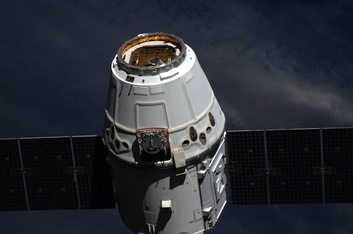 The SpaceX Dragon spacecraft (Credit: NASA) There is something both satisfying and frustrating about the historic space first achieved last Friday. Let's talk about positives first. What the SpaceX team has accomplished is nothing short of monumental: under the extraordinary leadership of former PayPal founder and owner Elon Musk, SpaceX has built and launched not only a single spacecraft, but an entire space system. Beginning with the Falcon 1 rocket, then on to the Falcon 9, SpaceX has demonstrated an ability to bring private-sector resources, experience, and capabilities to human spaceflight. But SpaceX didn't stop there. In addition to designing and building their own launch vehicles, SpaceX has designed and built the Dragon spacecraft. This remarkable vehicle -- like the Russian Soyuz and Progress spacecraft (which has been in service and has flown nearly continuously since 1967) -- is designed to carry both cargo and humans to and from low-Earth orbit, to the Moon, and to Mars and other far objects. It's important to be completely honest about this achievement: although primarily a private-enterprise effort, SpaceX has had an enormous amount of help from American taxpayers through NASA. Over the past decade or so the federal government, through NASA's Commercial Orbital Transportation Services (COTS) program, has channeled over $1 billion to SpaceX to support the Dragon-Falcon program. Federal-private sector contracting has been in place since the beginning of the American space program. As NASA's International Space Station program manager Mike Suffredini said in a recent interview, NASA has never built a spacecraft or rocket. That has always been done by private sector companies, but with extensive NASA oversight and using NASA's designs and requirements. What is different with SpaceX is that NASA -- in working to establish and grow the commercial spaceflight sector -- is simply subsidizing SpaceX, not leading it. To be sure, SpaceX must meet rigorous hardware and operational requirements set by NASA in integrating its systems into the ISS program. But SpaceX has designed, built, tested and flown its own spacecraft primarily through its own resources. This also demonstrates human spaceflight operations being conducted with private sector systems and efficiencies in place. Except for the earlier less-risk averse days of NASA, it would have been highly improbable to see a launch attempt aborted with .05 seconds until launch, the cause of the abort found quickly, and the vehicle turned around in two days. That rarely happens in today's NASA, but it happens in the private sector all the time. What we are seeing is the dawn of the next phase of human spaceflight where we will see private companies take their place next to government-sponsored programs. This is how it should be. Tomorrow, we'll talk about frustrations. But in the meantime, a major Memorial Day salute to SpaceX, to NASA, and to every other company and individual who had a hand in this past weekend's success. |
AuthorMike Salsgiver, 66, is a space enthusiast, a tech geek, and is active in federal, state, and local government and political circles. Mike lives in Portland, OR and enjoys RV traveling. Archives
December 2017
Categories |

 RSS Feed
RSS Feed